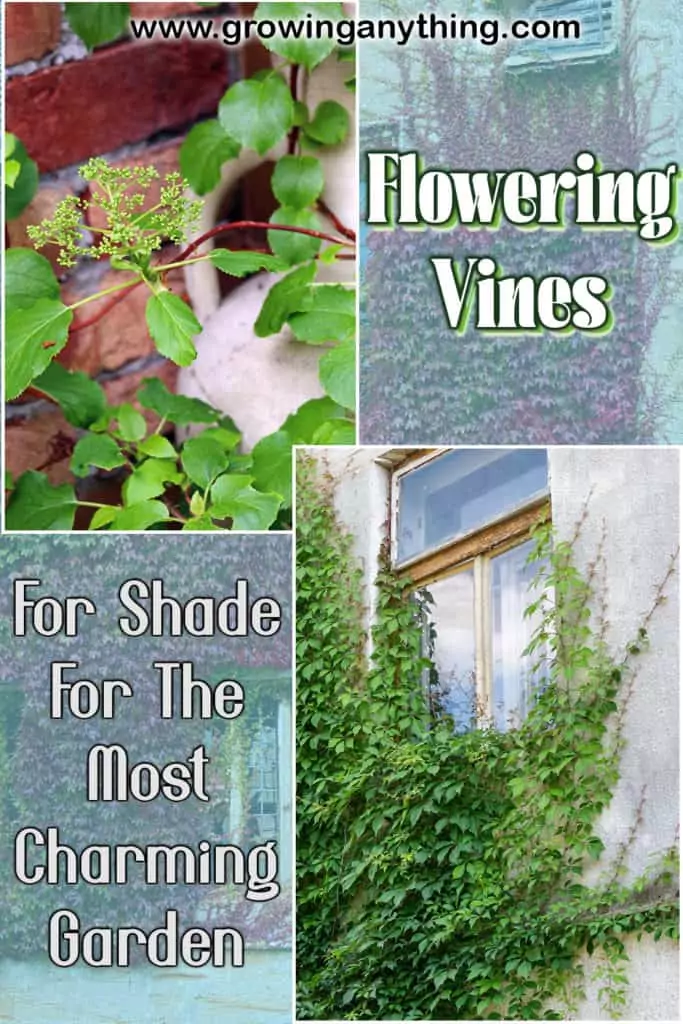21 Flowering Vines For Shade
If you have places in your garden that don’t get too much sun, why not fill in the bold areas with flowering vines for shade? Most of these vines are fast-growers, which means it won’t pass too much time before the plants award you with lush foliage and lovely flowers.
Using a trellis to support the vines in the shade allows you to create a charming space in your garden and train these vines to grow in the direction you want. Most vines that don’t require the sun to thrive are easy to grow and suitable for beginner gardeners.
Here are the best flowering vines for the north side of your garden and the areas where you don’t get sunlight!
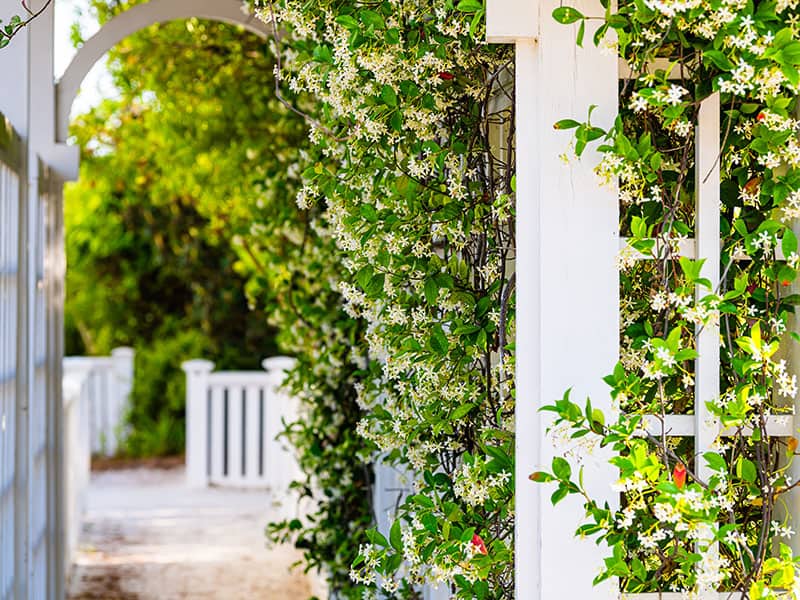
1. Climbing Hydrangea
Climbing Hydrangea or botanically, Hydrangea anomala petiolaris is a beautiful flowering vine that can also be grown as a shrub. But, if you decide to have it as the vine, you’ll need columns, trellis, or any supporting structure to be supportive. It is a massive vine that can grow between 30 and 80 feet tall.
If that is too tall for your garden, you can prune it to a shorter height.
The vine has dark green, heart-shaped leaves, and blooms in late spring. It develops clusters of small flowers that release the heavy scent.
Check out the tips for training your Climbing Hydrangea to climb!
2. Chinese Wisteria
Wisteria is among the most popular ornamental trees of all time. But, the American variety won’t produce flowers in the shade. If you want this plant in the shade, pick the Wisteria Sinensis variety.
Chinese Wisteria is actually a fast-grower, and you can expect it to grow around three or five feet per year. Unfortunately, the plant won’t flower for the first three or four years, so you’ll have to be patient to get those beautiful blossoms.
Check how to take care of your Chinese Wisteria in the shade!
Discover the best way to prune Wisteria. You can see this video to know more:
3. Boston Ivy
Lovely Parthenocissus tricuspidata is known by its common name Boston Ivy. The plant is easy to grow and gets the most beautiful in the autumn when the leaves turn red.
Boston Ivy can be grown in full sun or shade locations, and the plant tolerates all garden soil types. It is a vigorous climber, so you’ll need a large wall to ensure proper support. If you pick trellis, the plant will soon overgrow it, so you’ll need a bigger one.
Also, keep an eye on the plant to prevent it from damaging your wall, bricks, or nearby objects.
Here is a complete guide on how to grow Boston Ivy.
Check out why Boston Ivy is perfect for covering large outdoors walls.
4. Trumpet Vine

Trumpet vine is a beautiful plant with large, trumpet-shaped orange flowers. It is very popular among hummingbirds during summer, and it can take over your entire yard if you aren’t paying attention. Campsis radicans is a fast-growing plant and a very invasive one.
It is quite easy to grow because of high adaptivity. However, pick the planting location wisely and ensure a stable supporting structure. The blooming season is around three months, from June to September.
Find out if the Trumpet vine is a good choice for your hardiness zone!
5. Honeysuckle
If you love honey-scented items, you’ll adore the Honeysuckle plant or Lonicera serotina. The plant is a charming, slow-growing vine with tubular flowers and bluish-green foliage. Honeysuckle is sometimes called Late Dutch Honeysuckle.
It grows equally well in shade and sunny locations, but you need to ensure good drainage to the soil. Generally, Honeysuckle is a low-maintenance plant. You can plant it under a tree or support it with a trellis or pergola.
Discover more interesting facts about Honeysuckle.
Quick guide for successful planting of the Honeysuckle plant.
6. Chocolate Vine
Akebia quinata or Chocolate vine is a vigorous, perennial plant, best known for its purplish flowers and a subtle chocolate flower scent. It is one of the rare plants that smell like chocolate and grow like a vine.
People also called it the five-leaf Akebia vine because of the clustered foliage. The plant blooms in the spring, usually from March to May.
If the plant gets sunlight, it may produce edible, eggplant-like fruits later in the summer. The fruit has tiny black seeds and is a distant kiwi cousin.
Learn more about the unusual Chocolate vine.
Find out the reason why the fruits at your Chocolate vine aren’t opening.
7. Star Jasmine
Trachelospermum jasminoides, sometimes called Star or Confederate Jasmine, is an evergreen climbing plant with lush white flowers and dark green foliage. The plant looks beautiful all around the year, especially in autumn and blooming times. You can expect fragrant flowers to appear in mid-summer.
However, the plant isn’t frost-hardy, but only in case of severe cold temperatures. If you live in a mild climate, Star Jasmine is a low-maintenance plant.
Read more about ideal growing places for Star Jasmine!
8. Clematis
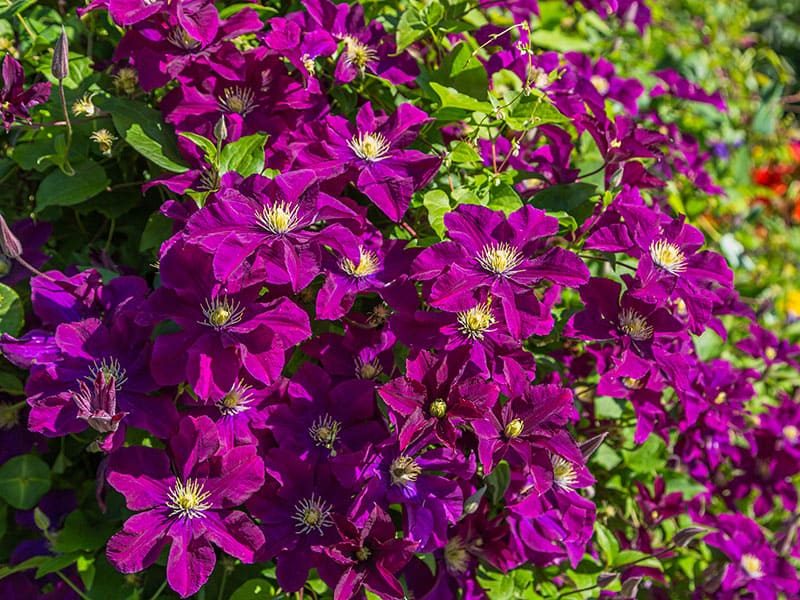
Clematis is probably the most popular genius of climbing gardening plants. The hybrid varieties, which produce large flowers, will thrive in the shade. The plants will grow faster especially if they get a minimal amount of sunlight.
You can grow your clematis around the fence where the tops of the plants will receive sunlight. The variety Clematis Montana will successfully grow in the shade, for example. It is a vigorous grower that needs the root to be moist.
You’ll have to water the plant and ensure a layer of mulch to retain the moisture around the roots.
Here are more useful tips on how to grow Clematis.
9. Lesser Periwinkle
Periwinkle is the flower with the unfortunate nickname – the flower of death. The plant comes from Europe, and it is an evergreen, invasive trailing vine plant. The botanical name of the plant is Vinca minor.
Periwinkle is known for its beautiful distinct purple flowering carpets in shaded areas. People also use Periwinkle for landscaping purposes. The plant is easy to grow and can grow even in the worst quality garden soils. However, keep an eye on the plant to prevent it from growing too fast and hijacking your entire garden!
Here are the best tips for growing Lesser Periwinkle in your shady garden.
10. Bleeding Heart
Clerodendrum thomsoniae or Bleeding heart plant is perfect for light shade locations in your garden. However, if you live in a chilly climate with lots of moisture, the plant can thrive in the full sun as well.
Other requirements for growing the plant are well-drained soil and moderate watering.
With a distinct appearance, deep-green leaves, and heart-shaped blossoms, Bleeding heart is one of the most beautiful plants to grow in the shade.
Here is everything you need to know before you start growing Bleeding heart in your garden!
11. Mandevilla
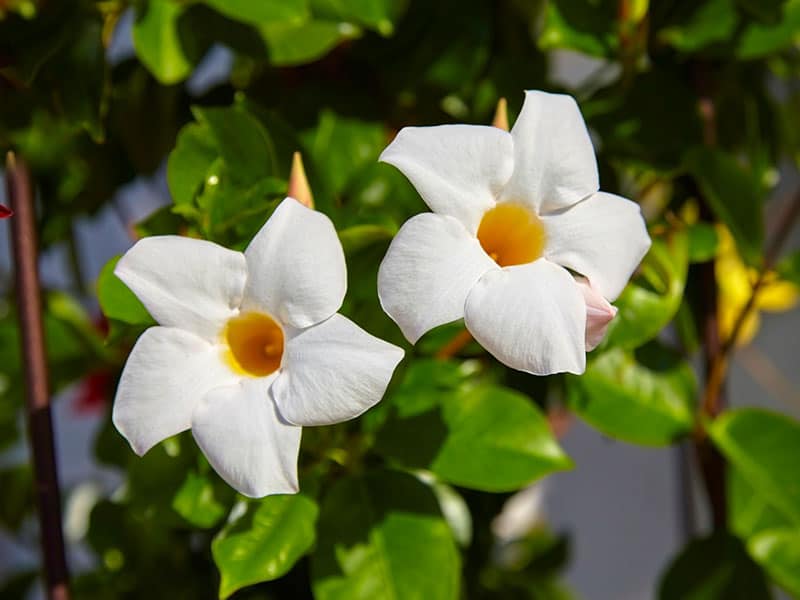
Mandevilla Boliviensis is native to Bolivia and Ecuador. Most people recognize the plant by its tall stems, elliptical dark green leaves, and charming white flowers. The plant is woody with trumpet-shaped flowers that appear in the summer.
However, Mandevilla can bloom year-long as long as the plant has the necessary care. It is also a pest-free, fast-growing plant that can reach up to ten feet.
However, be careful when growing Mandevilla around pets and children because the parts of the plant are poisonous.
Here is more useful information on the Mandevilla plant!
12. Sweet Pea
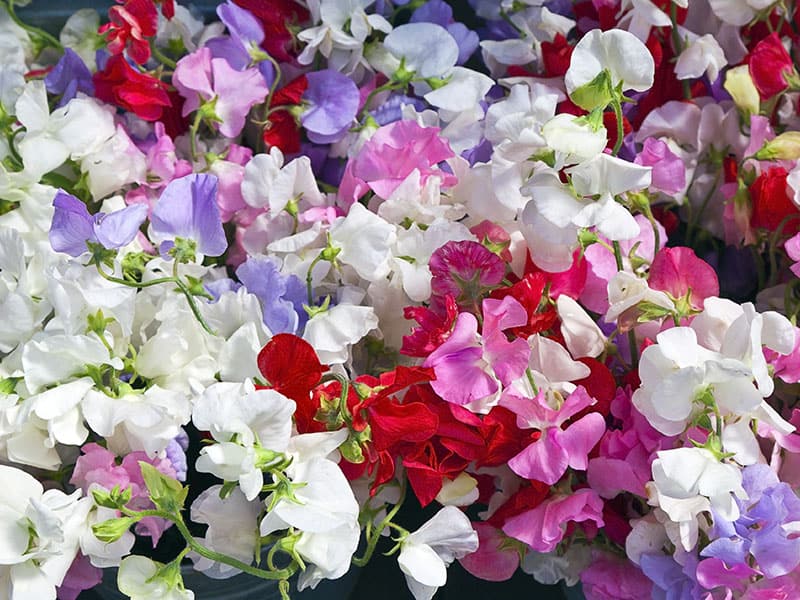
Sweet Pea or Lathyrus latifolius is a perennial vine that produces bright flowers in the summer. You can train the plant to climb on the tendrils, trellis, or fence. Some people use it for covering because of the lush foliage and tall stems.
The ideal time for planting Sweet Pea is in the early summer. Overall, the plant is easygoing and doesn’t have pests issues. It will grow better in partial than in full shade though.
Discover the guide for growing Sweet Pea in your garden!
13. Cross Vine
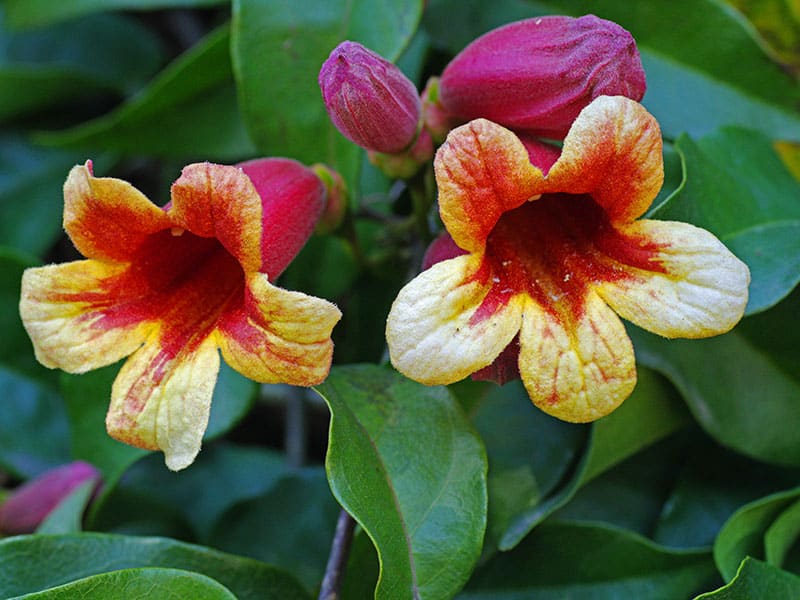
Bignonia Capreolata is a botanical name for Cross vine, a woody plant that can climb up to 50 feet in height. The vine produces snowy, orange blossoms in the shape of a trumpet. The flowers are divided into clusters, and each cluster can hold from two to five plants.
Cross vine looks beautiful when grown on the tendrils around stone and bricks, without support. Foliage is another attraction of this beautiful plant. The leaves are semi-evergreen, and they change their dark green color to a unique reddish shade in winter.
Find out more Cross Vine features before you plant it!
14. Kadsura
Kadsura japonica is one of the most elegant climbing vines you can grow in your garden. You can rarely find it in the South of the country because the plant thrives in colder climates and full shade.
Kadsura grows from 12 to 15 feet, and you can plant it near other climbing vines, trees, or shrubs. It is recognizable for its dark green and shiny pointed foliage. Tiny yellow flowers usually develop from summer to fall. There are several excellent varieties of this plant native to Japan and Korea. You can check Chirimen, Alba, or Fukurun cultivar for the most stunning appearance.
Read more about the unusual Kadsura plant!
15. Pothos
Epipremnum aureum is the scientific name for the plant you probably know as Pothos or Devil’s Ivy. Even though the plant will grow better when exposed to sunlight, you can easily grow it in the shade as well.
It will require monthly fertilization in fall and winter, and occasionally in spring. Also, only people who live in climates where the temperature doesn’t drop below 50 degrees Fahrenheit can grow this vine outside. Also, don’t forget to monitor mealybugs, as those are the most common problem with Pothos.
Learn what the ideal time to propagate Devil’s Ivy is.
16. American Groundnut
Apios Americana stands for American Groundnut, or Potato bean is a rare twining vine that produces edible tubers. The plant is a pea relative and has beautiful flowers that resemble Wisteria flowers.
The fruits of these plants taste similarly to a raw potato but with a nuttier aroma. The vines can grow up to ten feet tall.
In general, if you live in a warmer climate, the plant will thrive in the shady location. However, if you live in a chilly climate, your plant might not survive harsh winds and low temperatures.
Find out more about the American Groundnut!
17. Fortune Spindle
Euonymus fortunei, or Fortune spindle, is a short, ground covering vine. Most people use the plant to make low hedges and create structures around the walls. Fortune spindle is a resilient plant that grows in the sun or shade.
It is also a very frost-resistant plant, so it is an excellent choice for gardens in cold climates. Also, you can grow the plant despite the soil type. Ensure you water the plant moderately year-round and that you prune it to maintain the shape you like.
Here is all you need to know about the Fortune spindle.
18. Passion Flower
Passiflora likes the sun. But if you live in a warm climate, you can grow in partial or even full shade. The plant looks exotic and has a nasty reputation of being difficult to grow. Frost is the enemy number one of the Passion flower. If you manage to keep the plant alive, it will produce flowers from summer to autumn.
Despite being a vine, passion flowers grow on their own in shrub form. When grown in full sun, certain cultivars may produce fruits. But you shouldn’t expect it to happen in the shade.
Discover more practical tips on how to grow Passion Flower!
19. Chinese Virginia Creeper
Parthenocissus henryana is known by the name Chinese Virginia Creeper. It has a unique structure where light green flowers are usually hidden behind rich foliage. The plant produces flowers on the upper parts, normally in late spring. Also, in the fall, the Chinese Virginia Creeper develops black-blue berries.
The plant is picky as far as the soil quality and sun exposure grow. It will grow on its own in all types of soil, equally on full sun and full shade locations.
Find out why the Chinese Virginia Creeper might be the perfect plant for your garden!
How to make a trellis for your vines and climbers. You can see this video to know more:
20. Dutchman’s Pipe
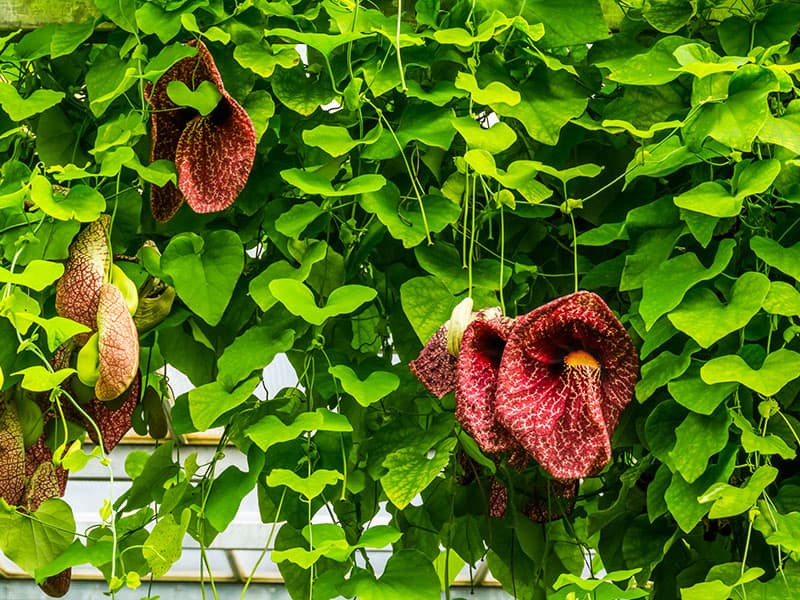
The vine with the unusual name Dutchman’s Pipe is native to northern parts of the USA and Canada. The botanical name of this charming plant is Aristolochia Macrophylla, but you might know it under other common names such as Wild Ginger, Pipevine or Broadleaf Birthwort. As you probably anticipate, it thrives in moist soil.
The plant develops shy, yellow flowers which usually get hidden behind the plant’s dense leaves. The species got the name because of the distinctive smoking pipe shape of the flowers.
Find out what kind of flowers does the Pipevine produce!
21. Nepalese Paper Plant
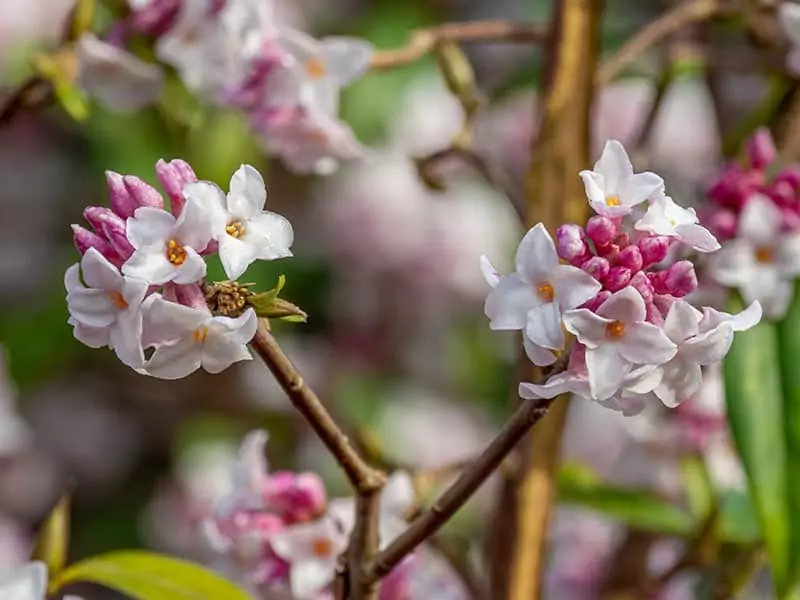
Daphne bholua, or Nepalese paper plant is a frost-hardy plant, and it can survive temperatures as low as 23 degrees Fahrenheit. You can grow it in partial shade as a delightful, flowering shrub with little to no effort at all.
The plant doesn’t prefer water and needs only a tiny amount of water to grow. It is a slow-growing plant, which doesn’t need pruning.
It develops fragrant flowers in different colors, pink, white, and yellow.
Find out more about Nepalese paper plant origin!
Use Every Foot of Your Garden with Shade-Tolerating Plants
Not everyone is blessed with a sunny garden and rich soil. Some of us have to find our way to fill in the areas that are in partial or full shade. Luckily, Mother Nature has you covered. There are excellent, easy-maintenance, and resilient vines and climbers that don’t need a lot of sunlight to grow.
Which plant is your top pick? Would you go for an obvious choice, such as Wisteria, or you prefer something more exotic, like a Nepalese Paper Plant?
If you find the article useful, please consider liking it!
